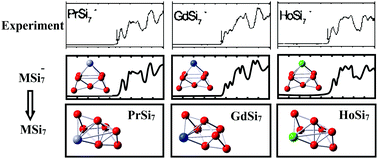Structural assignment, and electronic and magnetic properties of lanthanide metal doped silicon heptamers Si7M0/− with M = Pr, Gd and Ho†
Abstract
The ground state geometries of neutral and anionic lanthanide-metal-doped silicon clusters Si7M0/− with M = Pr, Gd and Ho were determined by quantum chemical (DFT) computations and the previous experimental photoelectron spectra were assigned. The hybrid B3LYP functional is suitable for predicting the ground electronic states of these Si clusters and reproducing well their photoelectron spectra. All the most stable isomers are substitutive derivatives of the bicapped octahedral pure Si80/− clusters. The bicapped octahedral Si7M is generated by substituting one Si atom on a plane of the D4h octahedron by one M atom. Replacement of a Si atom on the C2 axis of another bicapped octahedron by a lanthanide metal atom, where two capping Si atoms are situated in front of opposite triangular face on the side of the central square, gives rise to the anionic Si7M−. The limited participation of f-electrons of the lanthanide metal atoms on the valence electronic structure and thereby in the bonding of Si7M0/− induces high magnetic moments of the doped clusters. As a consequence, not only Si7M0/− but also SinLn0/− clusters can be regarded as suitable building blocks for assembling silicon-based cluster magnetic materials.


 Please wait while we load your content...
Please wait while we load your content...